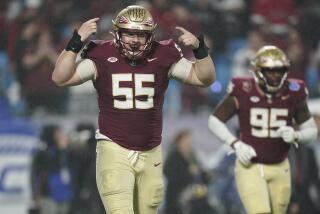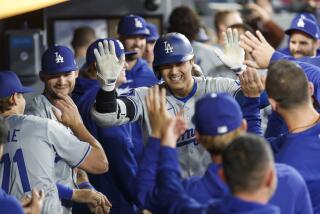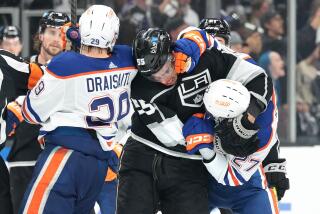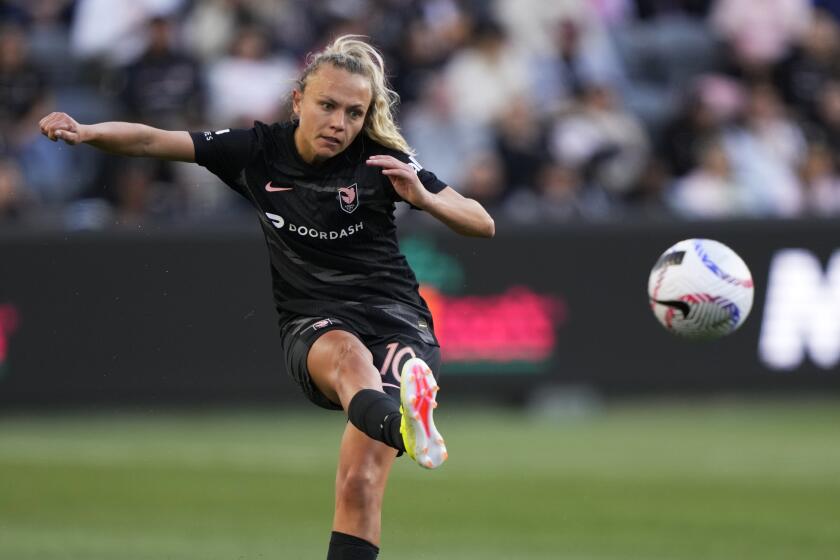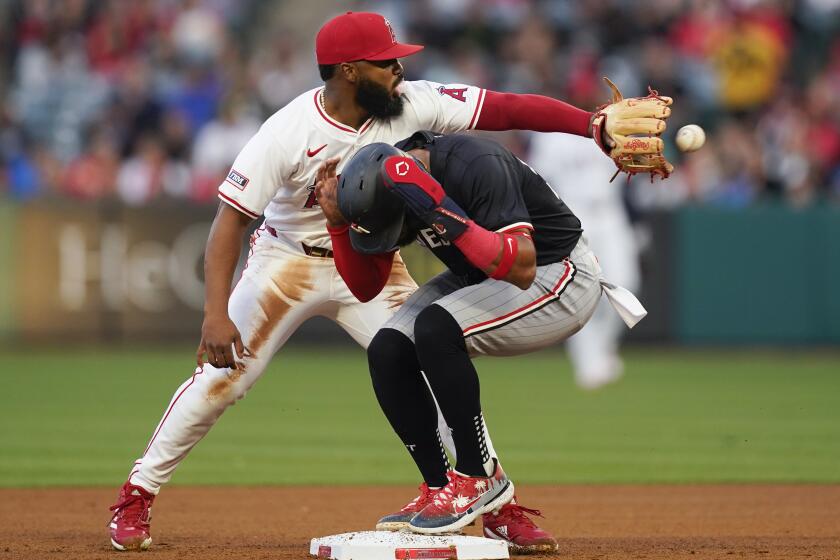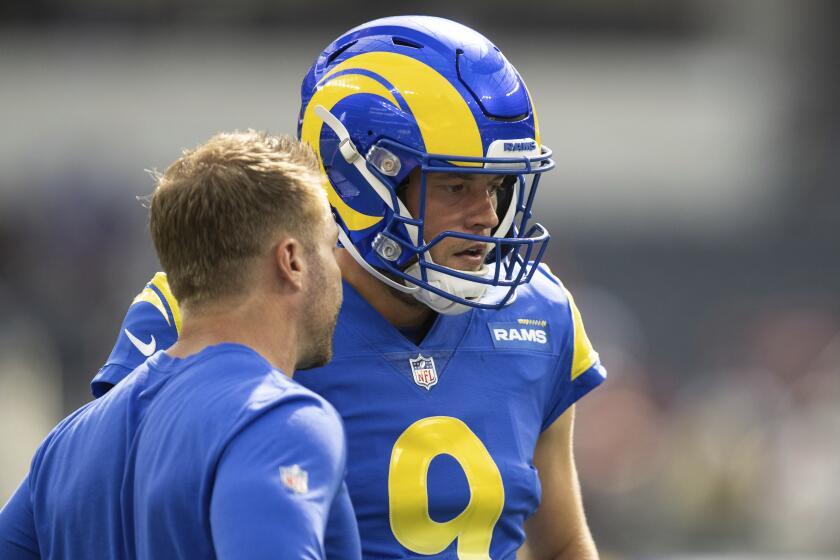Padres’ Move Is Major Change for San Diego
Once, it was a sign that the sunny city at the bottom of the state was coming of age and stepping out from its image as a minor league burg with a nice zoo and a Navy base.
In recent years it has become an object of political controversy and the site of mediocre baseball.
But, ah, the memories in the intervening 35 years: two World Series, two All-Star games, Ray Kroc’s startling announcement -- “I’ve never seen such stupid ballplaying in all my life!” -- Roseanne Barr’s crotch-grabbing version of “The Star Spangled Banner,” Steve Garvey’s triumphant home run that pushed the Padres toward the 1984 Series, and 20 glorious seasons by Tony Gwynn.
By nightfall Sunday, after the game between the Padres and Colorado Rockies is over, Qualcomm Stadium will no longer be a venue for major league baseball -- cynics suggest it hasn’t been for several years, as the Padres have taken up residency in last place.
On opening day 2004, the Padres will play in new Petco Park in downtown San Diego, approved by voters in 1998 as part of an ambitious redevelopment program for a rundown part of the city.
The city-owned Qualcomm will remain the football home of the San Diego State Aztecs and the NFL’s San Diego Chargers, although the Chargers’ arrangement is tenuous.
But the subject for this weekend is baseball, and what the Padres are billing as “Say Goodbye to the Q Weekend.” Anisha Gwynn, Tony’s daughter, will sing the national anthem, and former Padre player and coach Tim Flannery will lead a “Take Me Out to the Ballgame” sing-along in the seventh inning.
“I’ll miss Qualcomm, for sure,” said Steve Lehtola, a San Diego contractor and a Padre fan “since the days when Gaylord Perry was still denying he threw the spitter.”
“OK, it wasn’t the fanciest stadium but it was ours, it was San Diego’s,” Lehtola said in the concession line during Wednesday’s 2-1 loss to the Dodgers. “A lot of us grew up coming here and watching teams, some bad teams, some good teams ... well, actually, a lot of bad teams.”
Built in 1967 for $27.75 million, the then-San Diego Stadium was a leap of faith by voters who had endorsed a bond measure in 1965 by 72%. The chosen site was 166 acres in Mission Valley, far from downtown, which was then in decline as businesses fled for the suburbs.
The Chargers had already fled Los Angeles for San Diego, but Major League Baseball was noncommittal about San Diego when civic leaders convinced the public that a “multipurpose” stadium was needed. Build it and they will come, civic leaders promised.
And, indeed, in 1968 San Diego was awarded an expansion franchise, the team to assume the name used by the city’s Pacific Coast League entry for three decades. The minor league Padres played their final season at the new 52,000-seat stadium in 1968, and on April 8, 1969, the major league Padres beat Houston, 2-1. San Diego’s future had begun.
“Qualcomm was San Diego’s way of saying it had finally arrived as a metropolitan city,” said Marc Wolfsheimer, president of a San Diego consulting and asset management firm. “That we could support both an NFL team and a major league team was a big deal for the city.”
Not even loyalists are claiming that Qualcomm has the emotional hold of other stadiums. There is no ivy on the outfield walls, no wedding cake architecture, no Green Monster. The seats were comfortable, the grass was real, and the parking convenient, but it may have lacked the distinctive character of other parks.
“I remember Seals Stadium in San Francisco, with the smell of beer from the brewery wafting into the seats. Now that was a ballpark,” said James Jenkins, a landscaper, who was standing behind Lehtola. “Qualcomm is nice, but it’s not the kind of place I’ll be telling my grandkids about decades from now.”
One thing grandkids may be hearing about, however, is the outburst by then-owner Kroc, the McDonald’s magnate, on opening day 1974. With the Padres trailing the Houston Astros, 9-2, Kroc grabbed the public address microphone and ripped his own players.
“I suffer with you,” he told the crowd.
A streaker then bolted onto the playing field and led security guards on a merry chase as Kroc grew increasingly furious.
To the end, the stadium was versatile, able to accommodate football and baseball over the same weekend, plus an occasional tractor pull or rock concert. Its strength was also its weakness.
“Qualcomm is one of the finest places to watch any number of things, including baseball and football,” said lawyer and baseball fan John Wertz.
“But it’s not the best place for any one individual thing. It’s hard to feel nostalgic about Qualcomm.”
The team has one more piece of socko nostalgia planned: a return of the prankish San Diego Chicken after an absence of eight years. The Chicken is set to appear at tonight’s game.
Maybe the politically charged name changes played a role in distancing the stadium from its fans. Born as San Diego Stadium, it was renamed in the 1980s as San Diego-Jack Murphy Stadium, in honor of the late sports editor of the San Diego Union, a major force in persuading voters to favor the 1965 bond measure.
In 1997, with the city caught in litigation over an expansion project to make the stadium Super Bowl worthy, Qualcomm, the San Diego telecommunications giant, offered $18 million for naming rights.
Rather than risk taking the project to voters, city officials grabbed the offer and the Murph morphed to the Q. The 1997 expansion also completed the enclosing of the stadium, blocking off the vistas of hills and neon lights to the east. Football’s gain was baseball’s loss.
More to Read
Get our high school sports newsletter
Prep Rally is devoted to the SoCal high school sports experience, bringing you scores, stories and a behind-the-scenes look at what makes prep sports so popular.
You may occasionally receive promotional content from the Los Angeles Times.
